Lessons from 10 Years of Experience with Australia’s Risk-Based Guidelines for Managed Aquifer Recharge
Abstract
1. Introduction
2. Australian MAR Guidelines
- Pathogens,
- Inorganic chemicals,
- Salinity and sodicity,
- Nutrients,
- Organic chemicals,
- Turbidity/particulates,
- Radionuclides,
- Pressure, flow rates, volumes and levels,
- Contaminant migration in fractured rock and karstic aquifers,
- Aquifer dissolution and aquitard and well stability,
- Impacts on groundwater-dependent ecosystems, and
- Greenhouse gas emissions.
2.1. Reactions between Recharged Water and Aquifers
- Sustainable hazard removal. The Guidelines allow for pathogen inactivation, and biodegradation of some organic contaminants during the residence time of recharged water in the soil and/or aquifer within an attenuation zone of finite size.
- Ineffective hazard removal. These hazards need to be removed prior to recharge because they are either not removed (e.g., salinity) or removal is unsustainable (e.g., adsorption of any metals and organics that are not subsequently biodegraded, or excessive nutrients or suspended solids).
- New hazards introduced by aquifer interaction (e.g., metal mobilization, hydrogen sulphide, salinity, sodicity, hardness, or radionuclides). There is a need to change the quality of recharge water to avoid these (e.g., change acidity/alkalinity, reduction/oxidation status or reduce nutrients).
2.2. Zones of Influence of a MAR Operation
3. Experience that Suggests Future Refinement of MAR Guidelines
- A survey on MAR in Australia by the National Centre for Groundwater Research and Training (NCGRT) in 2015 with 134 respondents from all states.
- An update of the Guidelines for Groundwater Protection in Australia [9,10] and the South Australian Environmental Protection Policy for Water Quality [28] to enable a pathway to pragmatically define the environmental values of an aquifer, where these have not already been defined or where default values were unsupported by the facts, driven by MAR.
- An update on the South Australian Environmental Protection Policy for Water Quality [28] in 2015 where a previous arbitrary requirement for zero concentrations of herbicides was revised to conform with Aust. and N.Z. Guidelines for Fresh and Marine Water Quality 2000 [7] as periodically updated [8].
- Victorian Civil and Administrative Tribunal ruling in 2017 on reinjection of spent geothermal water into a geothermal aquifer.
- Experience in reinjection of desalinated, deoxygenated associated saline water from coal seam gas wells into a fresh water aquifer capable for use as drinking water supplies in Queensland.
- Experience in Western Australia in reinjection of dewatering water from iron ore mines to protect a groundwater-dependent salina and replenish needed groundwater resources.
- Experience in injection of advanced-treated recycled water into deep aquifers beneath Perth that contribute to public drinking water supplies.
- Lack of confidence in managing water quality, quantity and reliability of a recharge project on the Darling River in New South Wales for a drinking water supply for Broken Hill, that resulted in an alternative project being selected at four times the cost and with higher vulnerability to drought.
- Review of responses made since 2015 to the detection of per- and poly-fluoroalkyl substances (PFAS) in stormwater and aquifers in aquifer storage and recovery projects.
- Experience with cumulative impacts of aquifer storage and recovery schemes resulting in uncapped third-party wells overflowing in South Australia.
- Potential for problems of rising water table due to expansion of water sensitive urban design with increasing reliance on stormwater infiltration systems as a means of stormwater management but currently not considering potential groundwater impacts.
- A licenced allocation of groundwater for non-consumptive uses may be specified as an allowable net extraction (extraction minus reinjection);
- Reinjection of water is warranted to sustain the groundwater resource, even when the sustainable use limit is uncertain;
- Improving water use efficiency and reinjection are preferred to disposal of spent geothermal water to sea and much more so than disposal to leaky evaporation basins that increase the salinity of shallow groundwater;
- Reinjection gives benefits to groundwater users over a wide area by sustaining pressures whereas any residual risks of lowered temperature are primarily experienced by the holder of the licence;
- The benefits of carefully managed reinjection to the sustainability of the resource outweigh any residual risks to the resource attributes (such as reduced temperature);
- Good management of water quality and the reinjection system may make reinjection feasible, even in a complex, deep, aquifer used for geothermal operations;
- The costs of reinjection are considered commensurate with the benefits and not out of proportion with other costs of developing and utilising the groundwater resource;
- Reinjection is a part of the set of tools for adaptive management of groundwater for non-consumptive uses.
4. Research that Suggests Future Refinement of MAR Guidelines
- Research on deep well injection of brines from oil wells in USA suggests that fluid injection between 2 and 4 km in depth may be inducing seismicity with only marginal increases in pore pressure, suggesting that more explicit consideration of such risk for aquifer storage and recovery using deep wells in relevant geological settings.
- The update in 2018 of the Australian and New Zealand Environmental and Conservation Council (ANZECC) Water Quality Guidelines [8], based on research including that which has yielded improved genomics techniques to allow ecological impacts on aquifers and their connected ecosystems to be determined with higher reliability and reduced cost.
- Research has also resulted in improved methods to assess the sources and fate of pathogens recharged to aquifers to allow improved public health risk assessment.
- The advisory section of the Guidelines concerning the likelihood and extent of clogging and effectiveness of preventative and remedial strategies warrants updating.
5. Discussion and International Relevance
- adding temperature as a “hazard” in geothermal and open well ATES applications, and for explicit consideration of reactions within aquifers and contaminant removal processes (for organic and inorganic chemicals, microorganisms) and ecosystem impacts
- considering advances in scientific knowledge with respect to fluid-injection induced seismicity, fate of pathogens and organic chemicals, ecosystem monitoring methods, and clogging processes, which will make minor but warranted refinements to the Guidelines and extend their durability
- further elaborating project closure requirements, particularly where MAR is primarily for environmental benefit
- giving specific consideration of cumulative impacts of multiple MAR projects
- in the entry level section of the Guidelines, making more explicit the water entitlement arrangements for sourcing water, recharging aquifers, recovering from aquifers and end uses (e.g., [26]). In basins with groundwater levels in decline, groundwater management policies need to be strengthened to be effective in securing MAR entitlements.
6. Conclusions
Author Contributions
Funding
Acknowledgments
Conflicts of Interest
Abbreviations
| ASR | aquifer storage and recovery (injecting and recovering water from the same well) |
| ATES | aquifer thermal energy storage |
| MAR | managed aquifer recharge (the purposeful recharge of water to aquifers for subsequent recovery or environmental benefit. It is not a method for waste disposal.) |
References
- NRMMC; EPHC; NHMRC. Australian Guidelines for Water Recycling: Managing Health and Environmental Risks (Phase 2) Managed Aquifer Recharge. National Water Quality Management Strategy Document 24; National Water Resource Management Ministerial Council, Environment Protection and Heritage Council, National Health and Medical Research Council: Canberra, Australia, 2009; p. 237. Available online: http://www.waterquality.gov.au/guidelines/recycled-water (accessed on 19 January 2020).
- WHO; IWA. Water Safety Plan Manual; World Health Organization: Geneva, Switzerland; International Water Association: London, UK, 2009; Available online: https://www.who.int/water_sanitation_health/publications/publication_9789241562638/en/ (accessed on 19 January 2020).
- NRMMC; EPHC; AHMC. Australian Guidelines for Water Recycling: Managing Health and Environmental Risks. NWQMS Document 21; 2006. Available online: http://www.waterquality.gov.au/guidelines/recycled-water (accessed on 19 January 2020).
- NRMMC; EPHC; NHMRC. Australian Guidelines for Water Recycling: Managing Health and Environmental Risks (Phase 2). In Augmentation of Drinking Water Supplies; NWQMS Document 22; 2008. Available online: http://www.waterquality.gov.au/guidelines/recycled-water (accessed on 19 January 2020).
- NRMMC; EPHC; NHMRC. National Water Quality Management Strategy. Australian Guidelines for Water Recycling: Managing Health and Environmental Risks (Phase 2). In Stormwater Harvesting and Reuse; NWQMS Document 23; 2009. Available online: http://www.waterquality.gov.au/guidelines/recycled-water (accessed on 19 January 2020).
- ARMCANZ–ANZECC. National Water Quality Management Strategy: Policies and Principles—A Reference Document; Paper No 2; Australian and New Zealand Environment and Conservation Council & Agriculture and Resource Management Council of Australia and New Zealand: Canberra, Australia, 1994.
- ANZECC–ARMCANZ. Australian and New Zealand guidelines for fresh and marine water quality. National Water Quality Management Strategy; Paper No 4; Australian and New Zealand Environmental and Conservation Council, Agriculture Resource Management Council of Australia and New Zealand: Canberra, Australia, 2000.
- Water Quality Australia. Australian and New Zealand Guidelines for Fresh and Marine Water Quality. 2018. Available online: http://www.waterquality.gov.au/guidelines/anz-fresh-marine (accessed on 19 November 2019).
- ANZECC–ARMCANZ. Guidelines for groundwater protection in Australia. National Water Quality Management Strategy; Australian and New Zealand Environmental and Conservation Council, Agriculture and Resource Management Council of Australia and New Zealand: Canberra, Australia, 1995. Available online: https://www.water.wa.gov.au/__data/assets/pdf_file/0020/4925/8728.pdf (accessed on 19 January 2020).
- Water Quality Australia. Guidelines for groundwater quality protection in Australia. In National Water Quality Management Strategy; Department of Agriculture and Water Resources, 2013. Available online: https://www.waterquality.gov.au/sites/default/files/documents/guidelines-groundwater-quality-protection.pdf (accessed on 19 January 2020).
- ANZECC–ARMCANZ. Australian guidelines for water quality monitoring and reporting. In National Water Quality Management Strategy; Paper No 7; Australian and New Zealand Environmental and Conservation Council, Agriculture and Resource Management Council of Australia and New Zealand: Canberra, Australia, 2000. [Google Scholar]
- NHMRC–NRMMC (National Health and Medical Research Council and Natural Resource Management Ministerial Council). Australian Drinking Water Guidelines; NHMRC, NRMMC: Canberra, Australia, 2004. Available online: http://www.nhmrc.gov.au/publications/_files/adwg_11_06.pdf (accessed on 31 March 2009).
- Water Quality Australia. Australian Drinking Water Guidelines. 2011. Available online: https://www.waterquality.gov.au/guidelines (accessed on 19 January 2020).
- Dillon, P.; Kumar, A.; Kookana, R.; Leijs, R.; Reed, D.; Parsons, S.; Ingleton, G. Managed Aquifer Recharge—Risks to Groundwater Dependent Ecosystems—A Review. Water for a Healthy Country Report to Land and Water Australia; CSIRO: Canberra, Australia, 2009. Available online: www.clw.csiro.au/publications/waterforahealthycountry/2009/wfhc-managed-aquifer-recharge-risks.pdf (accessed on 19 January 2020).
- Dillon, P.; Toze, S. (Eds.) Water Quality Improvements During Aquifer Storage and Recovery, Vol 1. Water Quality Improvement Processes. (347p). Vol 2. Compilation of Information from Ten Sites; AWWARF Project 2618, Final Report; American Water Works Association Research Foundation: Denver, CO, USA, 2003; 347p. [Google Scholar]
- Pavelic, P.; Dillon, P.J.; Nicholson, B.C. Comparative evaluation of the fate of disinfection by-products at eight aquifer storage and recovery sites. Environ. Sci. Technol. 2006, 40, 501–508. [Google Scholar] [CrossRef] [PubMed]
- Vanderzalm, J.; Sidhu, J.; Bekele, G.-G.; Pavelic, P.; Toze, S.; Dillon, P.; Kookana, R.; Hanna, J.; Barry, K.; Yu, X.; et al. Water Quality Changes During Aquifer Storage and Recovery; Project #2974 Report; Water Research Foundation: Denver, CO, USA, 2009. [Google Scholar]
- Dillon, P.; Pavelic, P.; Page, D.; Miotlinski, K.; Levett, K.; Barry, K.; Taylor, R.; Wakelin, S.; Vanderzalm, J.; Molloy, R.; et al. Developing Aquifer Storage and Recovery (ASR) Opportunities in Melbourne—Rossdale ASR Demonstration Project Final Report. Water for a Healthy Country Report to Smart Water Fund. June 2010. Available online: http://clearwater.asn.au/resource-library/smart-water-fund-projects/developing-aquifer-storage-and-recovery-opportunities-in-greater-melbourne.php (accessed on 19 January 2020).
- Torkzaban, S.; Bradford, S.A.; Vanderzalm, J.L.; Patterson, B.M.; Harris, B.; Prommer, H. Colloid release and clogging in porous media: Effects of solution ionic strength and flow velocity. J. Contam. Hydrol. 2015, 181, 161–171. [Google Scholar] [CrossRef] [PubMed]
- Sasidharan, S. Fate, Transport, and Retention of Viruses, Bacteria, and Nanoparticles in Saturated Porous Media. Ph.D. Thesis, Flinders University of South Australia, Adelaide, Australia, 2016; p. 258. Available online: https://flex.flinders.edu.au/file/951c9bd7-c036-4c5b-b36b-478fbae8c417/1/Thesis_Sasidharan_2016.pdf (accessed on 25 March 2019).
- Rauch-Williams, T.; Hoppe-Jones, C.; Drewes, J.E. The role of organic matter in the removal of emerging trace organic chemicals during managed aquifer recharge. Water Res. 2010, 44, 449–460. [Google Scholar] [CrossRef] [PubMed]
- Li, D.; Alidina, M.; Drewes, J.E. Role of primary substrate composition on microbial community structure and function and trace organic chemical attenuation in managed aquifer recharge systems. Appl. Microbiol. Biotechnol. 2014, 98, 5747–5756. [Google Scholar] [CrossRef] [PubMed]
- Alidina, M.; Li, D.; Ouf, M.; Drewes, J.E. Role of primary substrate composition and concentration on attenuation of trace organic chemicals in managed aquifer recharge systems. J. Environ. Manag. 2014, 144, 58–66. [Google Scholar] [CrossRef]
- Bouwer, H.; Pyne, R.D.G.; Brown, J.; St Germain, D.; Morris, T.M.; Brown, C.J.; Dillon, P.; Rycus, M.J. Design, operation and maintenance for sustainable underground storage facilities. In American Water Works Association Research Foundation Report; Denver, CO, USA, 2008; p. 235. Available online: https://websites.pmc.ucsc.edu/~afisher/post/MAR_Papers/Bouwer2009_DesignSustainMAR.pdf (accessed on 19 January 2020).
- Dillon, P. Groundwater Replenishment with Recycled Water—An Australian Perspective. Groundwater 2009, 47, 492–495. [Google Scholar] [CrossRef]
- Ward, J.; Dillon, P. Robust policy design for managed aquifer recharge. Waterlines Report Series No 38. 2011, p. 28. Available online: https://apo.org.au/sites/default/files/resource-files/2011/02/apo-nid23758-1179541.pdf (accessed on 19 January 2020).
- Dillon, P.; Stuyfzand, P.; Grischek, T.; Lluria, M.; Pyne, R.D.G.; Jain, R.C.; Bear, J.; Schwarz, J.; Wang, W.; Fernandez, E.; et al. Sixty Years of Global Progress in Managed Aquifer Recharge. Hydrogeology 2019, 27, 1–30. [Google Scholar] [CrossRef]
- South Australia. Environment Protection (Water Quality) Policy. 2015. Available online: https://www.legislation.sa.gov.au/LZ/C/POL/Environment%20Protection%20(Water%20Quality)%20Policy%202015.aspx (accessed on 19 January 2020).
- Victoria EPA. State environment protection policy—Groundwaters of Victoria. In Victoria Government Gazette; No. S160; Victorian Govt. Printer: Melbourne, Australia, 17 December 1997. Available online: https://ref.epa.vic.gov.au/our-work/setting-standards/environmental-standards-reform/~/media/Publications/S160.pdf (accessed on 19 January 2020).
- Victoria Civil and Administrative Tribunal. Ruling on Peninsula Hot Springs Pty Ltd v Southern Rural Water (2017) VCAT 2103 (19 December 2017) Planning & Environment List VCAT Reference Nos. P2730/2015 & P1843/2016. 2017. Available online: http://www7.austlii.edu.au/cgi-bin/viewdoc/au/cases/vic/VCAT/2017/2103.html#fnB41 (accessed on 25 March 2019).
- Griebler, C.; Brielmann, H.; Haberer, C.M.; Kaschuba, S.; Kellermann, C.; Stumpp, C.; Hegler, F.; Kuntz, D.; Walker-Hertkorn, S.; Lueders, T. Potential impacts of geothermal energy use and storage of heat on groundwater quality, biodiversity, and ecosystem processes. Environ. Earth Sci. 2016, 75, 1391. [Google Scholar] [CrossRef]
- OGIA. Underground Water Impact Report for the Surat Cumulative Management Area. The Office of Groundwater Impact Assessment; Department of Natural Resources and Mines: Brisbane, Australia, 2016. Available online: https://www.dnrme.qld.gov.au/__data/assets/pdf_file/0007/345616/uwir-surat-basin-2016.pdf (accessed on 19 January 2020).
- Water Corporation. Groundwater Replenishment Trial Final Report. 2013. Available online: https://www.watercorporation.com.au/water-supply/our-water-sources/groundwater-replenishment (accessed on 31 March 2019).
- Schafer, D.; Donn, M.; Atteia, O.; Sun, J.; MacRae, C.; Raven, M.; Pejcicg, B.; Prommer, H. Fluoride and phosphate release from carbonate-rich fluorapatite during managed auifer recharge. J. Hydrol. 2018, 562, 809–820. [Google Scholar] [CrossRef]
- Lawrie, K.C.; Brodie, R.S.; Dillon, P.; Tan, K.P.; Gibson, D.; Magee, J.; Clarke, J.D.A.; Somerville, P.; Gow, L.; Halas, L.; et al. Broken Hill Managed Aquifer Recharge (BHMAR) Project: Assessment of Conjunctive Water Supply Options to Enhance the Drought Security of Broken Hill, Regional Communities and Industries—Summary Report. In Geosience Australia: Record 2012/15, Canberra, Australia; GeoCat #73823; 2012. [Google Scholar]
- Water Research Australia. PFAS Resources and Information. 2019. Available online: https://www.waterra.com.au/research/knowledge-transfer/pfas-resources-and-information/ (accessed on 31 March 2019).
- Page, D.; Vanderzalm, J.; Kumar, A.; Cheng, K.Y.; Kaksonen, A.H.; Simpson, S. Risks of Perfluoroalkyl and Polyfluoroalkyl Substances (PFAS) for Sustainable Water Recycling via Aquifers. Water 2019, 11, 1737. [Google Scholar] [CrossRef]
- South Australia Planning. On-Site Retention of Stormwater. Minister’s Specification SA 78AA. 2003. Available online: https://www.sa.gov.au/__data/assets/pdf_file/0017/7046/SA_78AA_Onsite_retention_of_stormwater.pdf (accessed on 25 March 2019).
- Hincks, T.; Aspinall, W.; Cooke, R.; Gernon, T. Oklahoma’s induced seismicity strongly linked to wastewater injection depth. Science 2018, 359, 1251–1255. [Google Scholar] [CrossRef] [PubMed]
- Batley, G.E.; van Dam, R.A.; Warne, M.S.t.J.; Chapman, J.C.; Fox, D.R.; Hickey, C.W.; Stauber, J.L. Technical Rationale for Changes to the Method for Deriving Australian and New Zealand Water Quality Guideline Values for Toxicants; Australian Government Department of Agriculture and Water Resources: Canberra, Australia, 2018.
- Warne, M.S.t.J.; Batley, G.E.; van Dam, R.A.; Chapman, J.C.; Fox, D.R.; Hickey, C.W.; Stauber, J.L. Revised Method for Deriving Australian and New Zealand Water Quality Guideline Values for Toxicants; Australian Government Department of Agriculture and Water Resources: Canberra, Australia, 2018.
- Lategan, M.J.; Klare, W.; Kidd, S.; Hose, G.C.; Nevalainen, H. The unicellular fungal tool RhoTox for risk assessments in groundwater systems. Ecotoxicol. Environ. Saf. 2016, 132, 18–25. [Google Scholar] [CrossRef] [PubMed]
- Korbel, K.; Chariton, A.; Stephenson, S.; Greenfield, P.; Hose, G.C. Wells provide a distorted view of life in the aquifer: Implications for sampling, monitoring and assessment of groundwater ecosystems. Sci. Rep. 2017, 7, 40702. [Google Scholar] [CrossRef] [PubMed]
- Korbel, K.L.; Hose, G.C. The weighted groundwater health index: Improving the monitoring and management of groundwater resources. Ecol. Indic. 2017, 75, 164–181. [Google Scholar] [CrossRef]
- Castaño-Sánchez, A.; Hose, G.C.; Reboleira, A.S.P.S. The ecotoxicological effects of anthropogenic stressors in subterranean organisms. Chemosphere 2020, 244, 125422. [Google Scholar] [CrossRef]
- Sidhu, J.; Toze, S.; Hodgers, L.; Barry, K.; Page, D.; Li, Y. Pathogen Decay during Managed Aquifer Recharge at Four Different Sites with Different Geochemical Characteristics and Recharge Water Sources. J. Environ. Qual. 2015, 44, 1402–1412. [Google Scholar] [CrossRef]
- Kitajima, M.; Sassi, H.P.; Torrey, J.R. Pepper mild mottle virus as a water quality indicator. NPJ Clean Water 2018, 1, 19. [Google Scholar] [CrossRef]
- Bradford, S.A.; Kim, H.; Head, B.; Torkzaban, S. Evaluating the Transport of Bacillus subtilis Spores as a Potential Surrogate for Cryptosporidium parvum Oocysts. Environ. Sci. Technol. 2016, 50, 1295–1303. [Google Scholar] [CrossRef]
- Stange, C.; Sidhu, J.; Toze, S.; Tiehm, A. Comparative removal of antibiotic resistance genes during chlorination, ozonation, and UV treatment. Int. J. Hygiene Environ. Health 2019, 222, 541–548. [Google Scholar] [CrossRef]
- Martin, R. (Ed.) Clogging Issues Associated with Managed Aquifer Recharge Methods; IAH Commission on Managing Aquifer Recharge, Monograph, 2013; Available online: https://recharge.iah.org/files/2015/03/Clogging_Monograph.pdf (accessed on 19 January 2020).
- Wang, Z.; Du, X.; Yang, Y.; Ye, X. Surface clogging process modeling of suspended solids during urban stormwater aquifer recharge. J. Environ. Sci. 2012, 24, 1418–1424. [Google Scholar] [CrossRef]
- Du, X.; Zhang, H.; Ye, X.; Lu, Y.Y. Flow velocity effects on Fe(III) clogging during managed aquifer recharge using urban storm water. Water 2018, 10, 358. [Google Scholar] [CrossRef]
- Johnston, K.; Nelson, D. Hartfield Park water proofing project: Stormwater harvesting using aquifer storage and recovery. In Proceedings of the 10th International Conference on Water Sensitive Urban Design, Perth, Australia, 14 February 2018; p. 7, ISBN 978-1-925627-03-9. [Google Scholar]
- Parsons, S.; Dillon, P.; Irvine, E.; Holland, G.; Kaufman, C. Progress in Managed Aquifer Recharge in Australia; National Water Commission Waterlines Report Series No 73; SKM & CSIRO: 2012; National Water Commission: Canberra, Australia, 2012; p. 107. [Google Scholar]
- Victoria Environment Protection Agency. Guidelines for Managed Aquifer Recharge (MAR)—Health and Environmental Risk Management. Publication 1290: Melbourne, Australia. 2009. Available online: https://www.epa.vic.gov.au/about-epa/publications/1290 (accessed on 19 January 2020).
- WA Department of Water. Operational Policy 1.01. Managed Aquifer Recharge in Western Australia. 2011. Available online: http://www.newwaterways.org.au/downloads/Resources%20-%20Policy%20and%20Guidelines/Water%20reuse%20and%20recycling/Operational%20Policy%201_01%20-%20Managed%20aquifer%20recharge%20in%20WA.pdf (accessed on 31 March 2019).
- West, C.; Kenway, S.; Hassall, M.; Yuan, Z. Why do residential recycled water schemes fail? A comprehensive review of risk factors and impact on objectives. Water Res. 2016, 102, 271–281. [Google Scholar] [CrossRef] [PubMed]
- West, C.; Kenway, S.; Hassall, M.; Yuan, Z. Expert opinion on risks to the long-term viability of residential recycled water schemes: An Australian study. Water Res. 2017, 120, 133–145. [Google Scholar] [CrossRef] [PubMed][Green Version]
- Kretschmer, P. Managed aquifer recharge schemes in the Adelaide metropolitan area. In DEWNR Technical Report 2017/22; Government of South Australia, Department of Environment, Water and Natural Resources: Adelaide, Australia, 2017; p. 48. [Google Scholar]
- Marsden Jacob Associates. Economic Viability of Recycled Water Schemes; Australian Water Recycling Centre of Excellence: Brisbane, Australia, 2013; Available online: http://www.marsdenjacob.com.au/wp-content/uploads/2014/11/Economic-viability-of-recycled-water-schemes.pdf (accessed on 29 March 2019).
- Mankad, A.; Walton, A.; Alexander, K. Key dimensions of public acceptance for managed aquifer recharge of urban stormwater. J. Clean. Prod. 2015, 89, 214–223. [Google Scholar] [CrossRef]
- Dillon, P.; Vanderzalm, J.; Sidhu, J.; Page, D.; Chadha, D. A Water Quality Guide to Managed Aquifer Recharge in India. CSIRO Land and Water, UNESCO Report of AusAID PSLP Project ROU 14476. 34p+appendices. 2014. Available online: https://recharge.iah.org/files/2016/11/A-Water-Quality-Guide-to-MAR-in-India-2014.pdf (accessed on 25 March 2019).
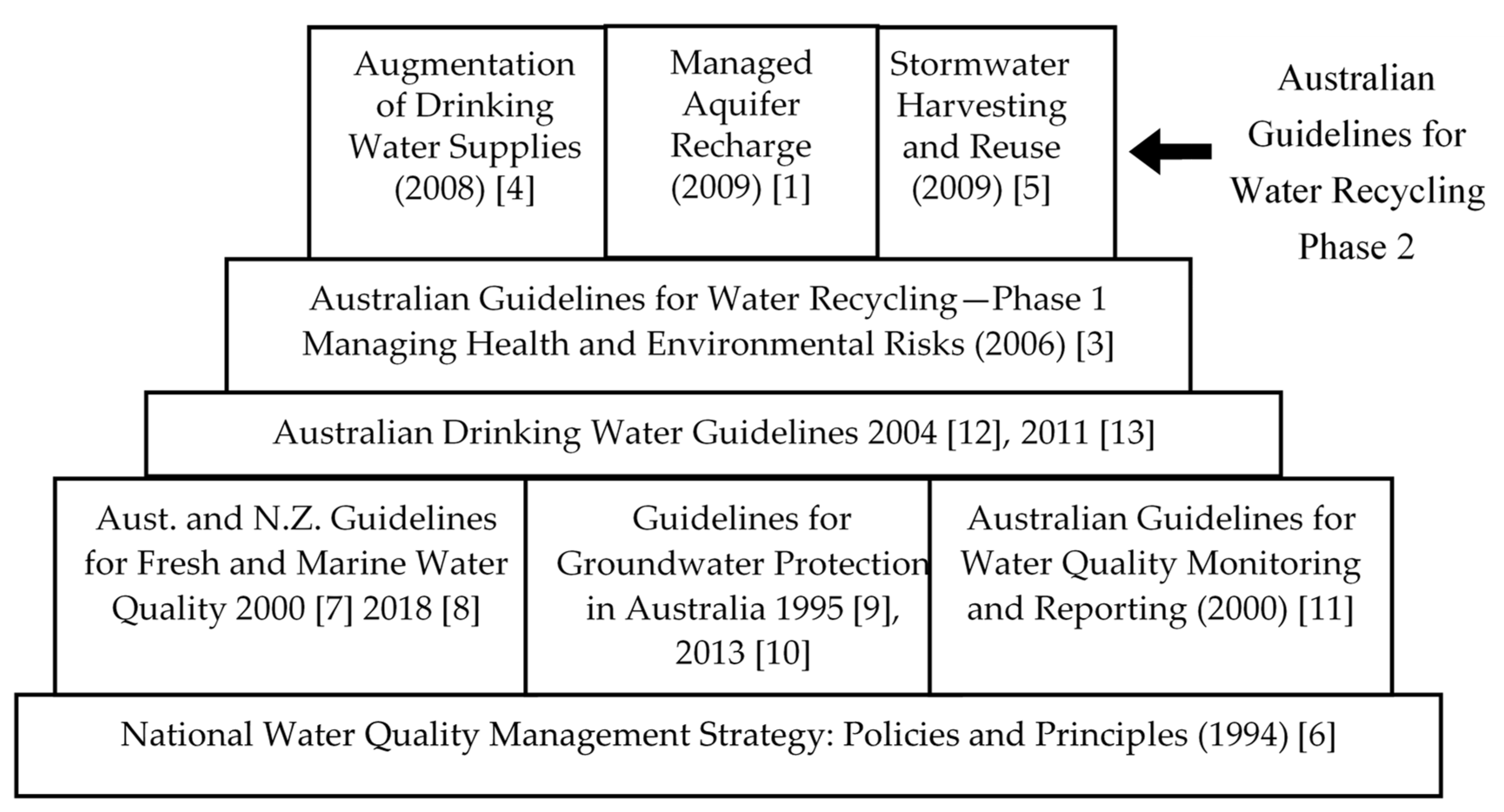
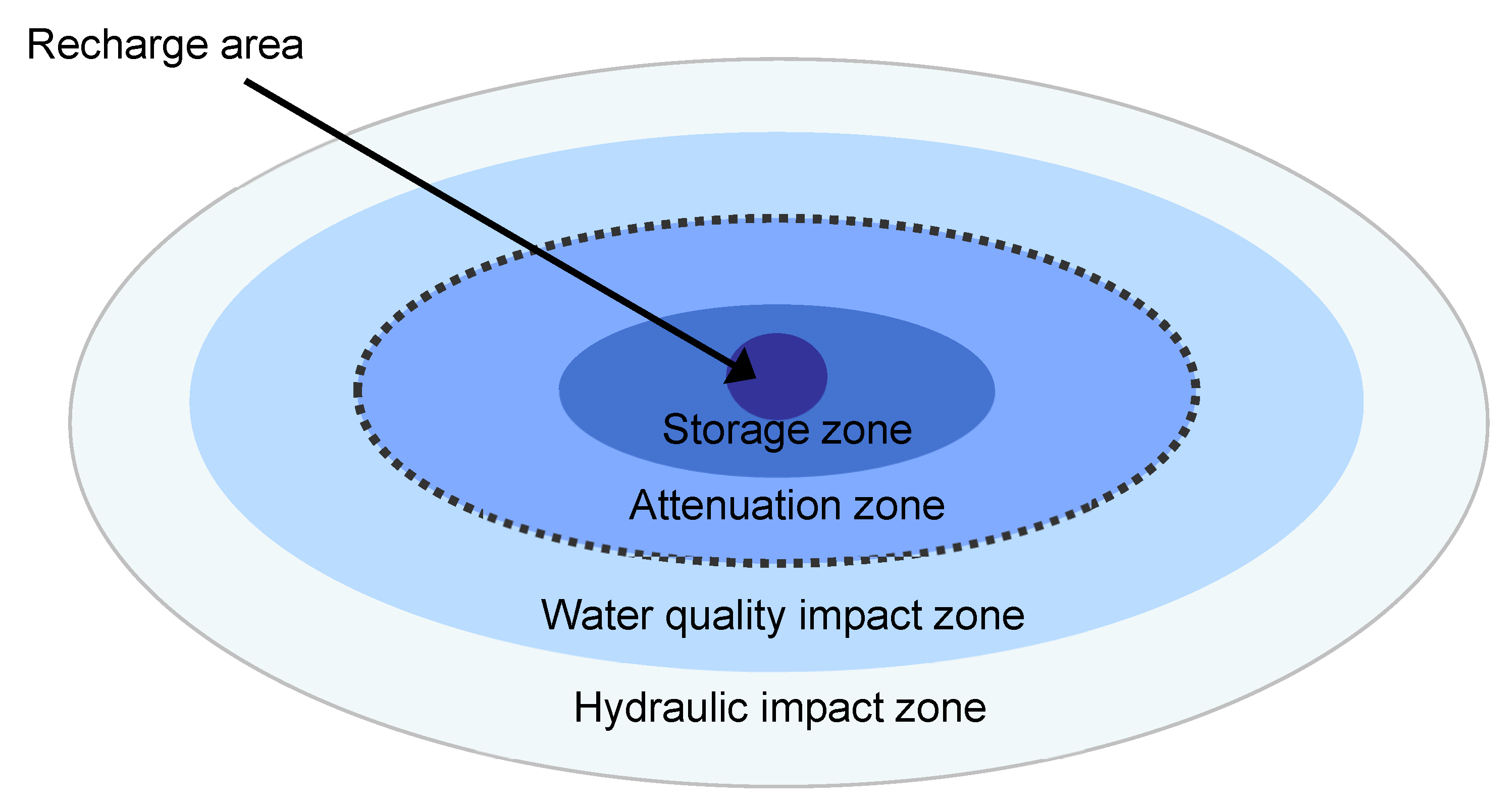
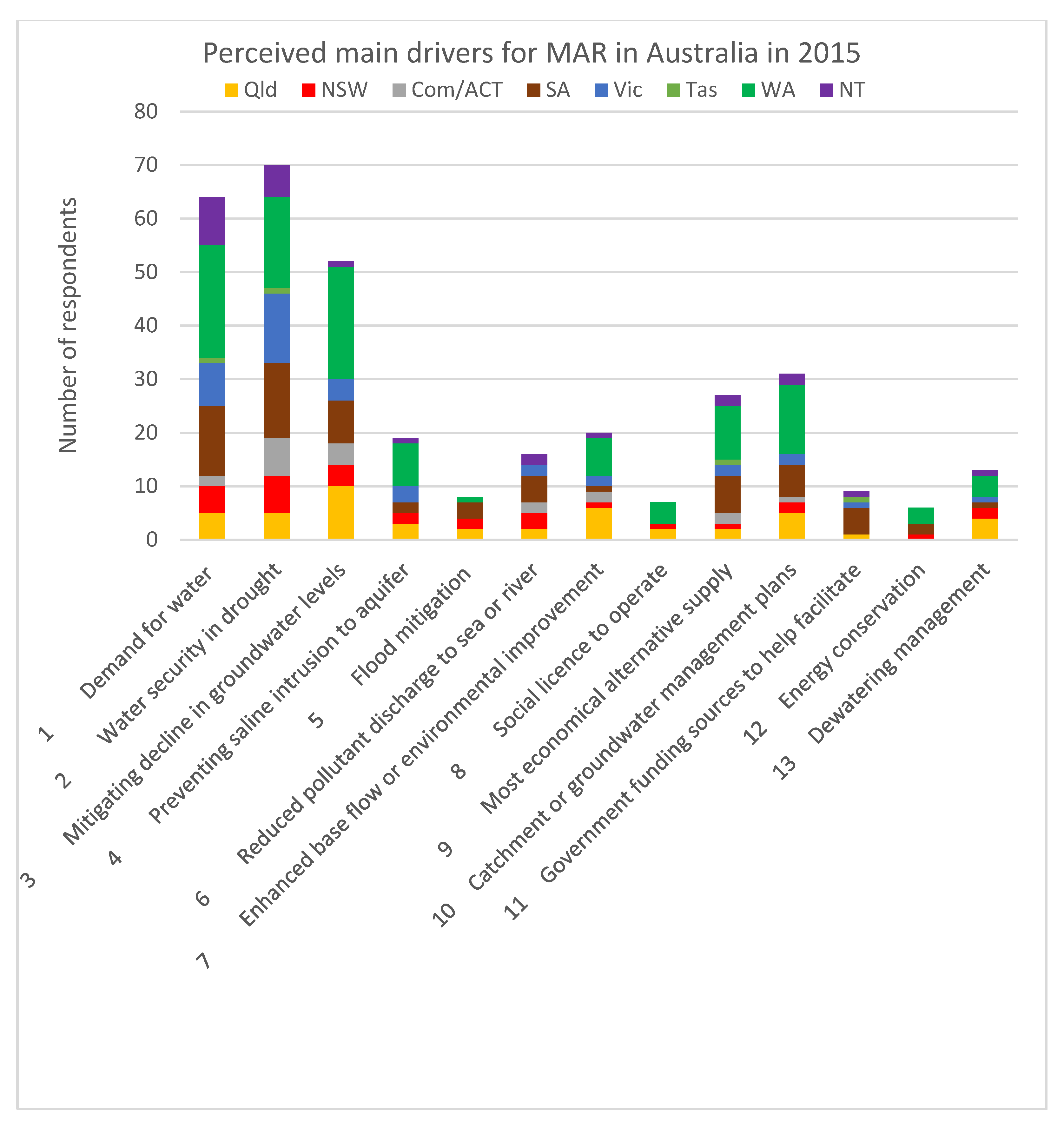
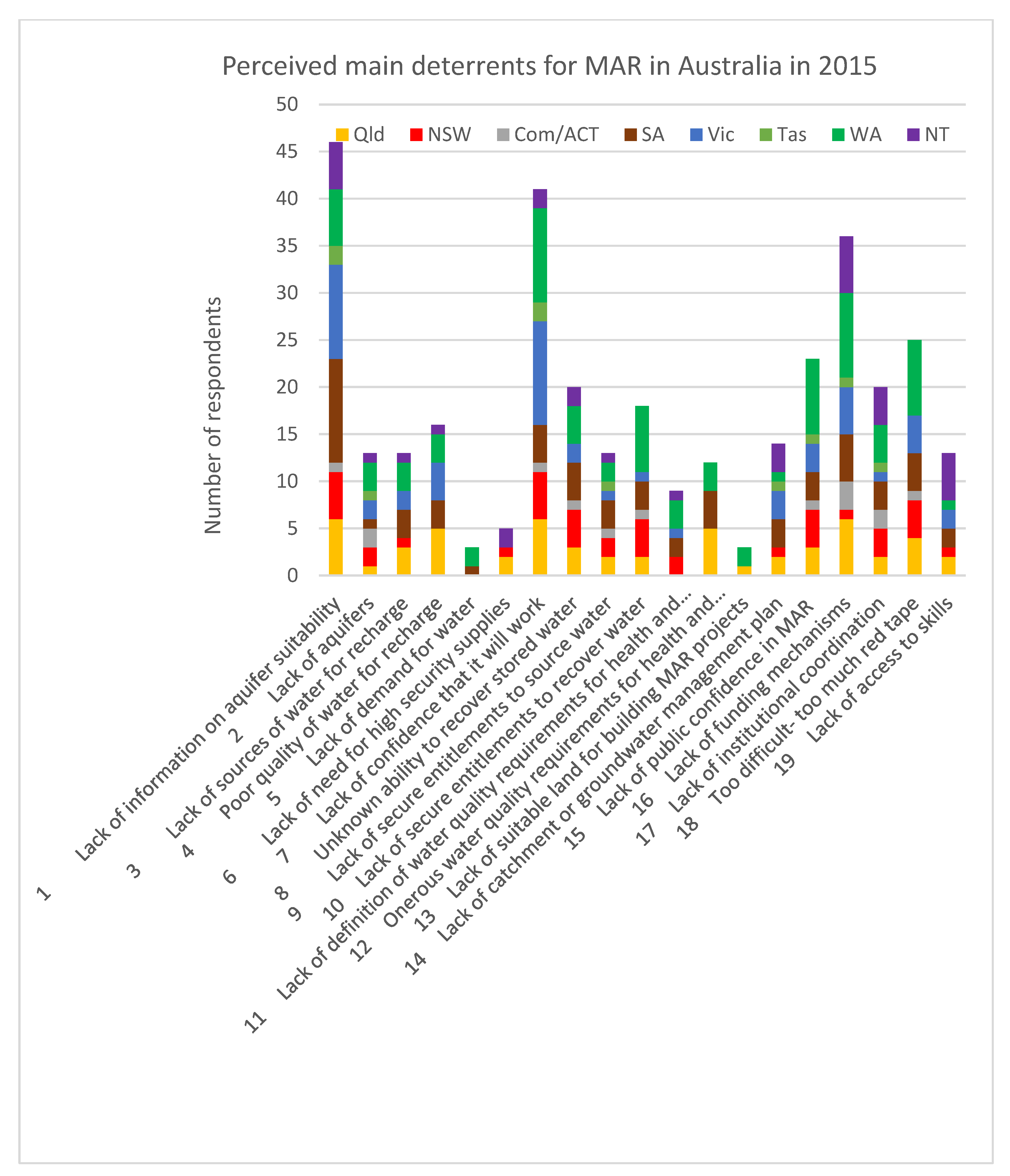
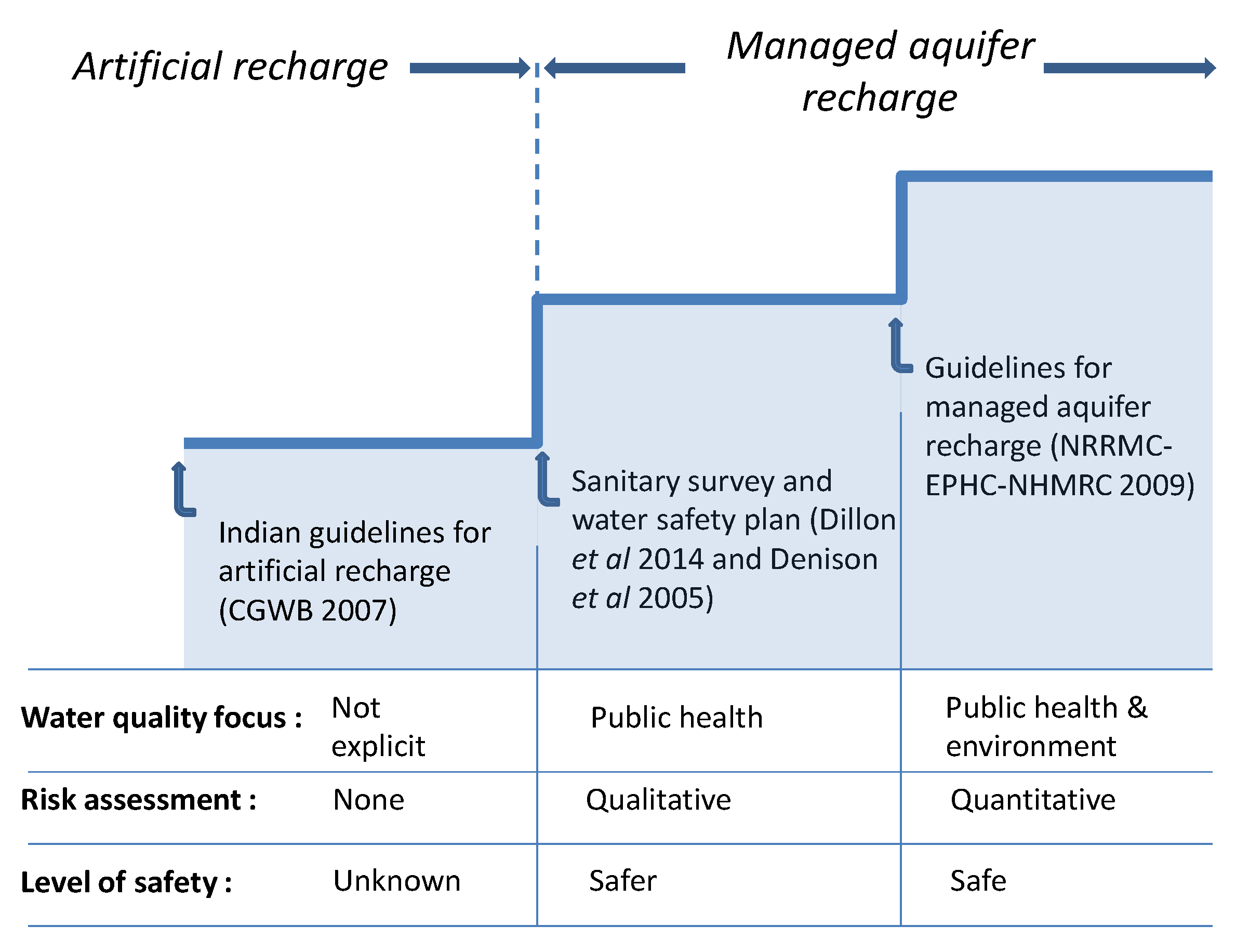
© 2020 by the authors. Licensee MDPI, Basel, Switzerland. This article is an open access article distributed under the terms and conditions of the Creative Commons Attribution (CC BY) license (http://creativecommons.org/licenses/by/4.0/).
Share and Cite
Dillon, P.; Page, D.; Vanderzalm, J.; Toze, S.; Simmons, C.; Hose, G.; Martin, R.; Johnston, K.; Higginson, S.; Morris, R. Lessons from 10 Years of Experience with Australia’s Risk-Based Guidelines for Managed Aquifer Recharge. Water 2020, 12, 537. https://doi.org/10.3390/w12020537
Dillon P, Page D, Vanderzalm J, Toze S, Simmons C, Hose G, Martin R, Johnston K, Higginson S, Morris R. Lessons from 10 Years of Experience with Australia’s Risk-Based Guidelines for Managed Aquifer Recharge. Water. 2020; 12(2):537. https://doi.org/10.3390/w12020537
Chicago/Turabian StyleDillon, Peter, Declan Page, Joanne Vanderzalm, Simon Toze, Craig Simmons, Grant Hose, Russell Martin, Karen Johnston, Simon Higginson, and Ryan Morris. 2020. "Lessons from 10 Years of Experience with Australia’s Risk-Based Guidelines for Managed Aquifer Recharge" Water 12, no. 2: 537. https://doi.org/10.3390/w12020537
APA StyleDillon, P., Page, D., Vanderzalm, J., Toze, S., Simmons, C., Hose, G., Martin, R., Johnston, K., Higginson, S., & Morris, R. (2020). Lessons from 10 Years of Experience with Australia’s Risk-Based Guidelines for Managed Aquifer Recharge. Water, 12(2), 537. https://doi.org/10.3390/w12020537









